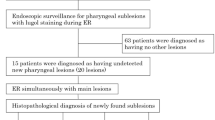Abstract
Background
Metachronous cancer rate in the pharynx is high before and after the treatment of esophageal cancer. Endoscopic observation is difficult in the pharynx especially in the postcricoid area. Pharyngeal cancer in the postcricoid area has been often found in advanced stage. Valsalva maneuver has been reported to improve the visibility.
Methods
From May 2017 we introduced a dedicated mouthpiece to conduct Valsalva maneuver. One hundred consecutive patients who had been observed throughout the pharynx by one endoscopist were enrolled. A total of 200 image files before and after introduction were made and reviewed by three endoscopists. We retrospectively evaluated the utility and safety of Valsalva maneuver.
Results
The visibility before introduction was Good in three cases, Moderate in 12 cases and Poor in 85 cases. Meanwhile, the visibility after introduction was Good in 58 cases, Moderate in 23 cases, and Poor in 19 cases (P < 0.05). Nine lesions including hypopharyngeal cancer were found and adverse events were not observed in this study.
Conclusion
The Valsalva maneuver was considered to be a safe and effective method in endoscopic observation of the pharynx.




Similar content being viewed by others
References
Wahlberg PC, Andersson KE, Bi€orklund AT, M€oller TR. Carcinoma of the hypopharynx: analysis of incidence and survival in Sweden over a 30-year period. Head Neck. 1998;20:714–9.
Eckel HE, Staar S, Volling P, Sittel C, Damm M, Jungehuelsing M. Surgical treatment for hypopharynx carcinoma: feasibility, mortality, and results. Otolaryngol Head Neck Surg. 2001;124:561–9.
Muto M, Minashi K, Yano T, et al. Early detection of superficial squamous cell carcinoma in the head and neck region and esophagus by narrow band imaging: a multicenter randomized controlled trial. J Clin Oncol. 2010;28:1566–72.
Iizuka T, Kikuchi D, Hoteya S, et al. Clinical advantage of endoscopic submucosal dissection over endoscopic mucosal resection for early mesopharyngeal and hypopharyngeal cancers. Endoscopy. 2011;43:839–43.
Iizuka T, Kikuchi D, Hoteya S, Yahagi N, Takeda H. Endoscopic submucosal dissection for treatment of mesopharyngeal and hypopharyngeal carcinomas. Endoscopy. 2009;41:113–7.
Kato M, Hayashi Y, Takehara T. Valsalva maneuver to visualize the closed hypopharyngeal space during transoral endoscopy using a novel dedicated mouthpiece. Dig Endosc. 2019;31:e24–e2525.
Kato M, Ishihara R, Hamada K, et al. Endoscopic surveillance of head and neck cancer in patients with esophageal squamous cell carcinoma. Endosc Int Open. 2016;4:e752–e755755.
Katada C, Yokoyama T, Yano T, et al. Alcohol consumption and multiple dysplastic lesions increase risk of squamous cell carcinoma in the esophagus, head, and neck. Gastroenterology. 2016;151:860–9.
Rodrigues J, Breda E, Monteiro E. Surgically-treated locoregionally advanced hypopharyngeal cancer: outcomes. Int Arch Otorhinolaryngol. 2018;22:443–8.
Kadapa N, Mangale K, Watve P, Rao SLM, Raju AK, Subramanyeshwar RT. Postcricoid carcinoma: is organ preservation justified in T3? Laryngoscope. 2015;125:356–9.
Murono S, Tsuji A, Endo K, Kondo S, Wakisaka N, Yoshizaki T. Evaluation of modified Killian’s method: a technique to expose the hypopharyngeal space. Laryngoscope. 2014;124:2526–30.
Sakai A, Okami K, Sugimoto R, et al. A new technique to expose the hypopharyngeal space: the modified Killian’s method. Auris Nasus Larynx. 2014;41:207–10.
Freeman SR, Keith AO, Aucott W, Kazmi N, Nigam A. Comparison between two valsalva techniques for improvement of hypopharyngeal nasendoscopy: a preliminary communication. Clin Otolaryngol. 2007;32:488–91.
Hamada K, Ishihara R, Yamasaki Y, et al. Transoral endoscopic examination of head and neck region. Dig Endosc. 2018;30:516–21.
Yamasaki Y, Ishihara R, Hamada K. Usefulness of the Valsalva maneuver without a mouthpiece to observe the hypopharynx using transoral endoscopy. Dig Endosc. 2017;29:643–4.
Tanaka T, Niwa Y, Tajika M, et al. Prospective evaluation of a transnasal endoscopy utilizing flexible spectral imaging color enhancement (FICE) with the Valsalva maneuverfor detecting pharyngeal and esophageal cancer. Hepatogastroenterology. 2014;61:1627–34.
Kikuchi D, Iizuka T, Yamada A, et al. Utility of magnifying endoscopy with narrow band imaging in determining the invasion depth of superficial pharyngeal cancer. Head Neck. 2015;37:846–50.
Iwatsubo T, Ishihara R, Nakagawa K et al. Pharyngeal observation via transoral endoscopy using a lip cover type mouthpiece. J Gastroenterol Hepatol. 2018. (Epub ahead of print).
Park JH, Sagong M, Chang W. Valsalva retinopathy following esophagogastroduodenoscopy under propofol sedation: a case report. World J Gastroenterol. 2014;20:3056–8.
Kilincalp S, Çoban Ş, Yüksel I. An alarming condition after upper gastrointestinal endoscopy: valsalvaretinopathy. Gastroenterol Nurs. 2013;36:465–6.
Yamasaki Y, Ishihara R, Hanaoka N, et al. Pethidine hydrochloride is a better sedation method for pharyngeal observation by transoral endoscopy compared with no sedation and midazolam. Dig Endosc. 2017;29:39–48.
Author information
Authors and Affiliations
Corresponding author
Ethics declarations
Ethical Statement
The study protocol was approved by the Institutional Review Board of Toranomon hospital. In this retrospective study, only anonymous data was used, so provision of informed consent was waived.
Conflict of interest
All authors declare that there are no conflicts of interest.
Additional information
Publisher's Note
Springer Nature remains neutral with regard to jurisdictional claims in published maps and institutional affiliations.
Rights and permissions
About this article
Cite this article
Kikuchi, D., Tanaka, M., Suzuki, Y. et al. Utility of Valsalva maneuver in the endoscopic pharyngeal observation. Esophagus 17, 323–329 (2020). https://doi.org/10.1007/s10388-020-00722-z
Received:
Accepted:
Published:
Issue Date:
DOI: https://doi.org/10.1007/s10388-020-00722-z




